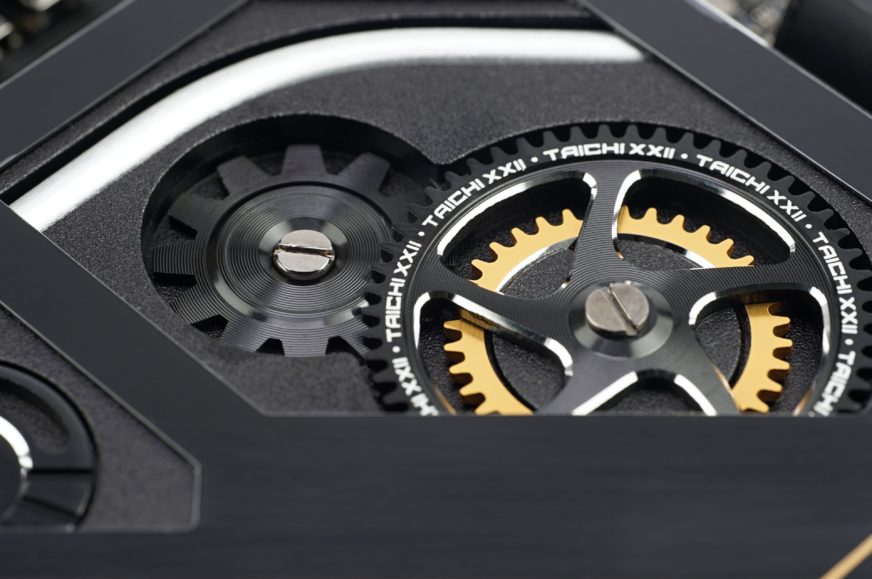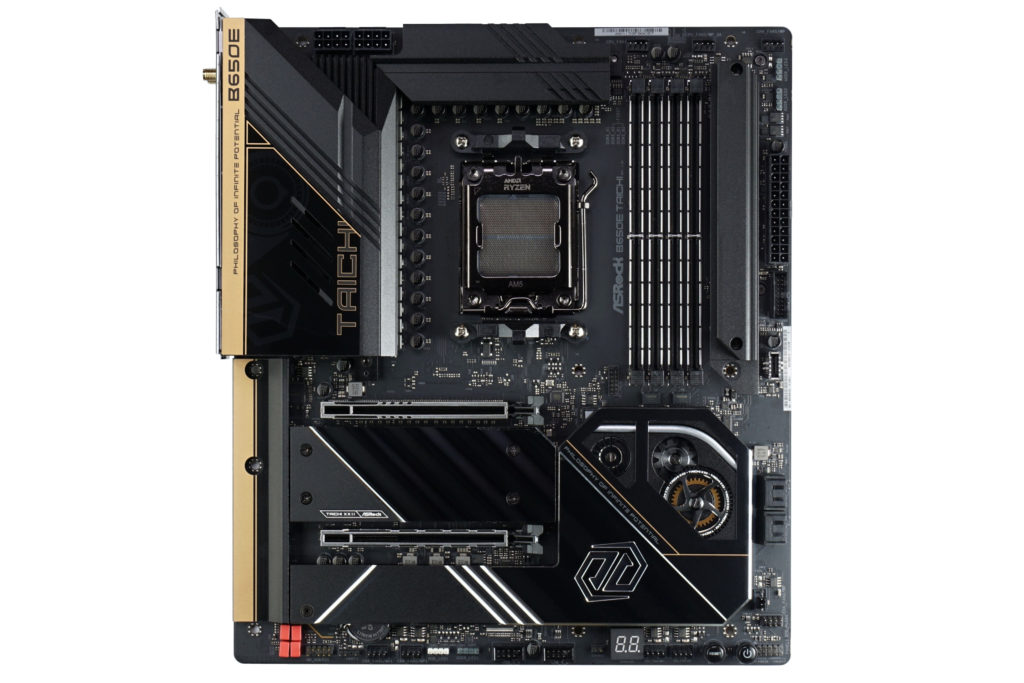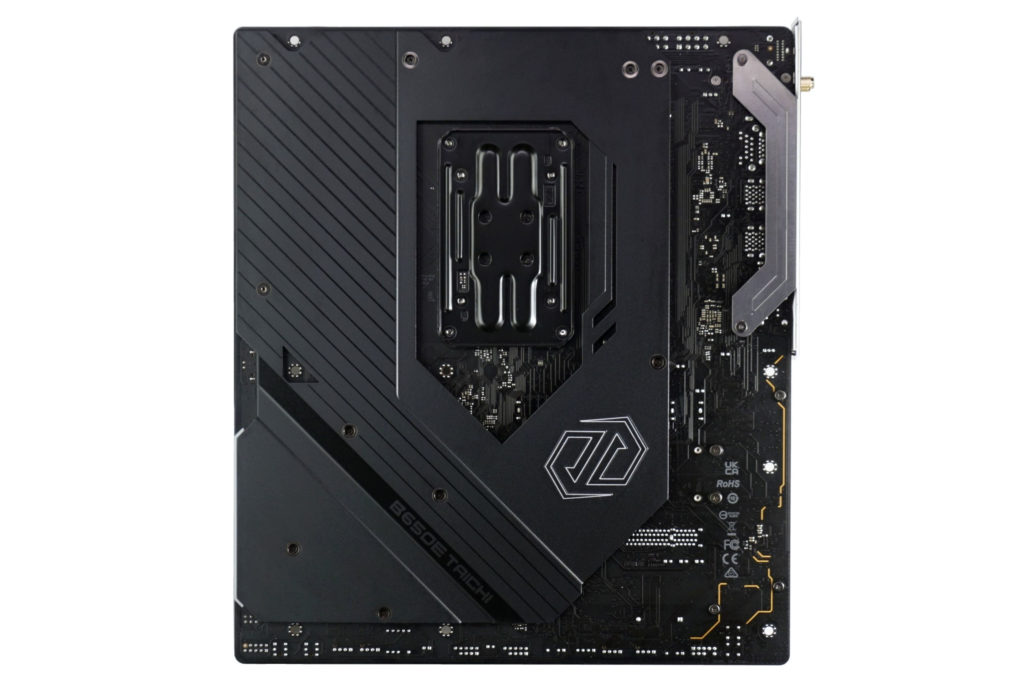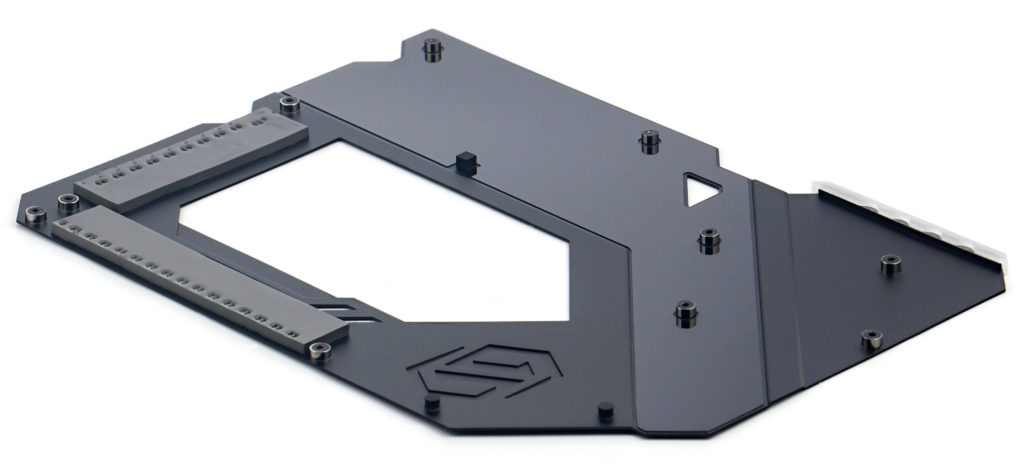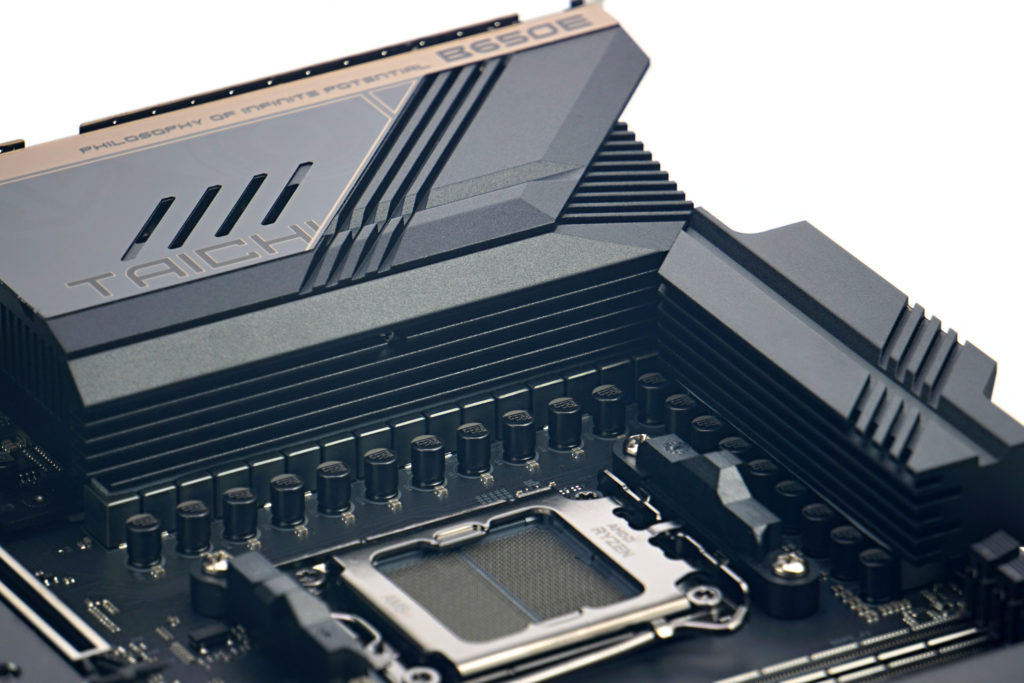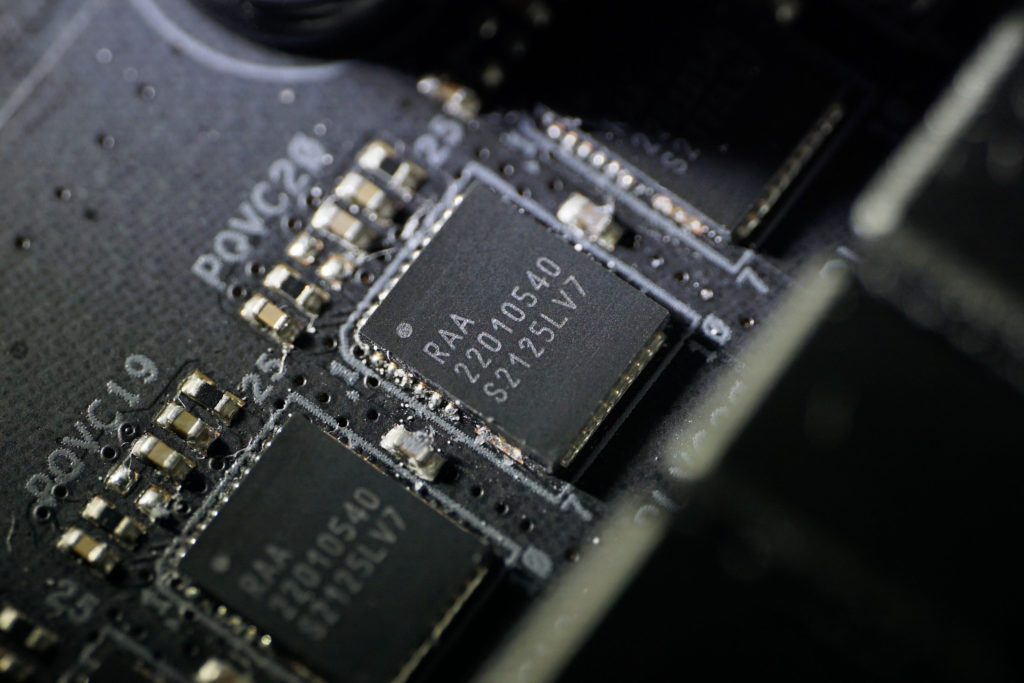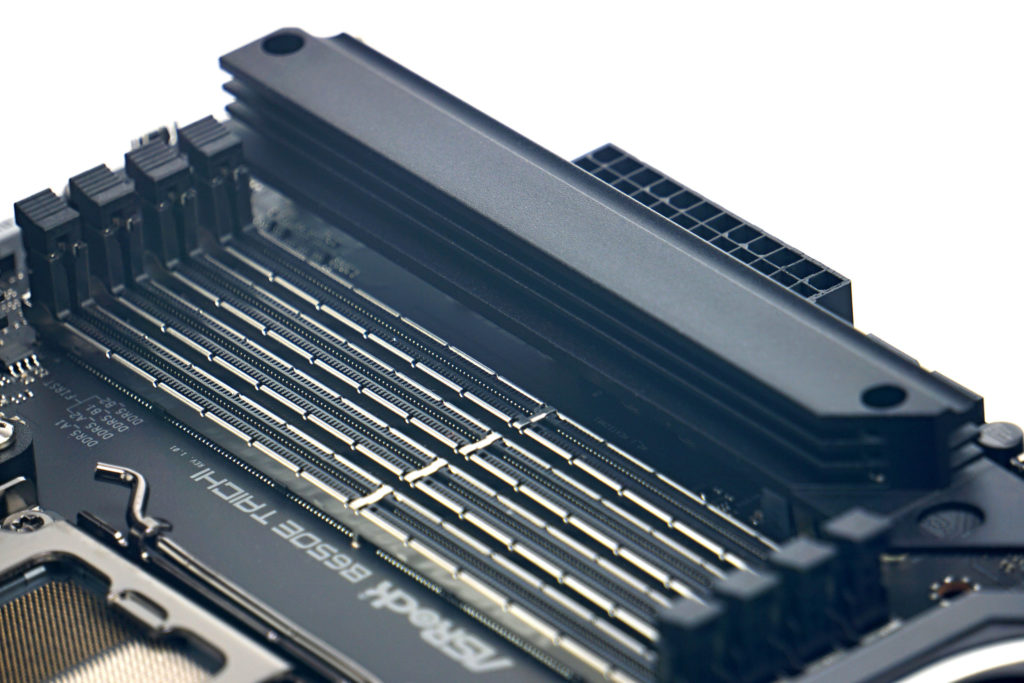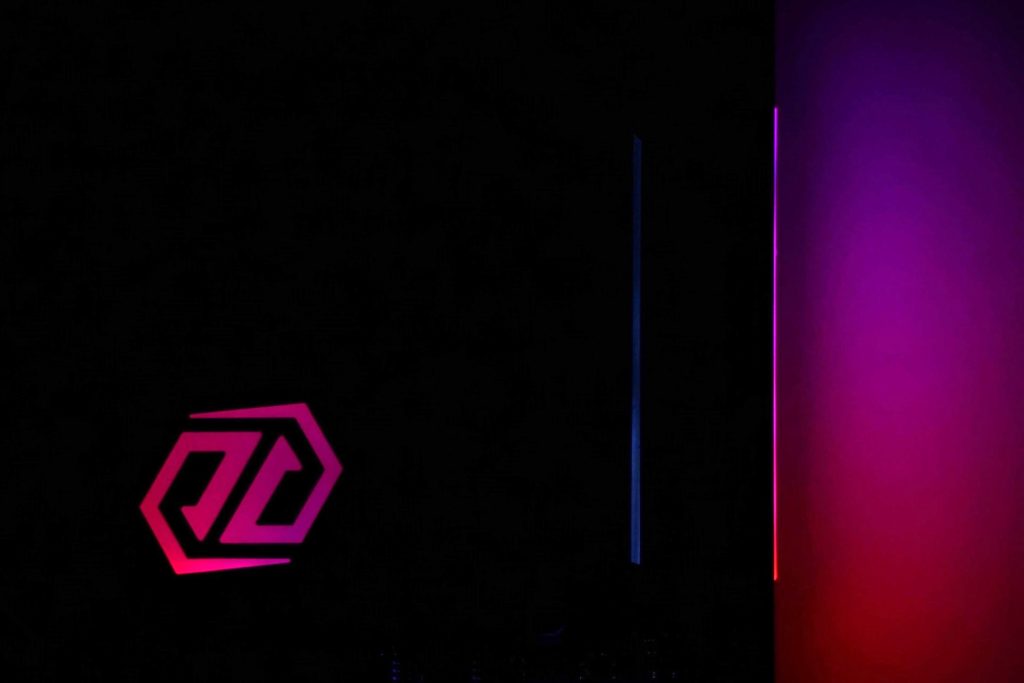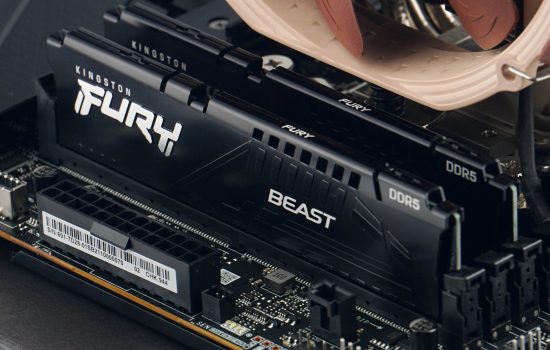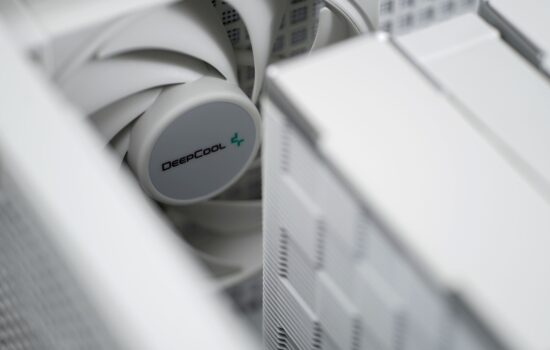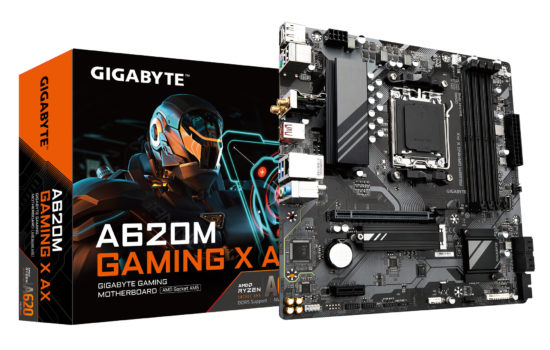ASRock B650E Taichi in detail
The AMD B650E chipset is a compromise solution to some extent, but the ASRock Taichi motherboard that is based on it makes an ultimate impression. And it’s not just a “feel”, it really is that… The VRM of the CPU didn’t fit in our thermal image with the standard procedure. There are a few quirks and things that you might find it worth tweaking, but those are usually related to other things, like the more modest chipset features.
Combining an expensive, high-end board with an AMD B650E chipset may seem odd at first, but when you realize that the connectivity of the higher-end X670E chipset (i.e. two B650E chips) is beyond what you can grasp, it starts to make sense. Often you may not even hit the limits of the B650E chipset’s capabilities.
| Parameters | ASRock B650E Taichi | |
| Socket | AMD AM5 | |
| Chipset | AMD B650E | |
| Format | E-ATX (305 × 267 mm) | |
| CPU power delivery | 27-phase | |
| Supported memory (and max. frequency) | DDR5 (6600 MHz) | |
| Slots PCIe ×16 (+ PCIe ×1) | 2× (+ 0×) | |
| Centre of socket to first PCIe ×16 slot | 85 mm | |
| Centre of socket to first DIMM slot | 56 mm | |
| Storage connectors | 4× SATA III, 3× M.2 (1× PCIe 5.0 ×4: 30–110 mm + 2× M.2 PCIe 4.0 ×4: 80 mm) | |
| PWM connectors for fans or AIO pump | 8× | |
| Internal USB ports | 1× 3.2 gen. 2×2 type C, 2× 3.2 gen. 1 type A, 4× 2.0 type A | |
| Other internal connectors | 1× TPM, 3× ARGB LED (5 V), 1× RGB LED (12 V) | |
| POST display | yes | |
| Buttons | Start, Reset, Flash BIOS, Clear CMOS | |
| External USB ports | 1× 4 (Thunderbolt 4) type C, 3× 3.2 gen. 2 type A, 8× 3.2 gen. 1 type A | |
| Video outputs | 1× HDMI 2.1 | |
| Network | 1× RJ-45 (2,5 GbE) – Intel Killer E3000, WiFi 6E (802.11 a/b/g/n/ac/ax), Bluetooth 5.3 | |
| Audio | Realtek ALC4082 (5.1) with DAC ESS Sabre9218 | |
| Other external connectors | – | |
| Manufacturer's suggested retail price | 475 EUR |
ASRock B650E Taichi
In ASRock’s motherboard hierarchy for the AMD AM5 platform, the B650E Taichi is a cheaper derivative of the X670E Taichi. We will touch on the basic things that make the difference in the text.
The width of this board is as much as 267 mm, which at 305 mm of height means that it is an E-ATX format. This is used where the PCB area of smaller ATX boards isn’t enough, although some places are perhaps a little more barren than you might expect. There are only four SATA ports (if you need more, the X670E Taichi has eight) and only three M.2 slots for SSDs (there are four on the X670E Taichi). These are limitations imposed at the chipset level, which naturally has a finite number of PCIe lanes, and this is lower than the X670E variant. On the B650E Taichi, you can also forget about connecting a second pair of USB 3.2 gen. 1 ports on the front panel of the case.
In terms of PCI Express 5.0 interface support for the graphics card, the B650E Taichi has only one such slot. On the X670E Taichi, PCIe 5.0 is supported by two slots. The latter has both of them connected to the CPU. On the B650E Taichi board, the second PCIe ×16 slot is only connected to the chipset, thus the slower PCIe 4.0 lanes. This has one advantage, however, in that the lanes are not redistributed (×8/×8) when using both slots and the full number of lanes is always available.
As befits a high-end board, a backplate is also included with the B650E Taichi. This not only protects the PCB during mounting (there are cases where you tap the SMD into the spacer and the fun is over…), but also contributes to the cooling of the VRM (Vcore and SOC). It is in contact with the PCB through a thick thermal pad.
Two things about the power delivery attract particular attention. One is the enormous number of phases, 27, and the other you have to take a closer look at. On the decorative cover between the heatsink and the external I/O connectors, there is a small grille next to the “Taichi” lettering. Behind it hides a small, 40-millimeter axial fan. If you start looking for its parameters according to its designation (T124010SH), you’ll see from the datasheet that it has double ball bearings (i.e. decent, durable ones) and reaches a speed of 7000 rpm. However, you will not encounter it in practice.
Fans on motherboards are a bogeyman, but mostly probably because users portray unrealistic scenarios of “how noisy it’s going to be”, it’s not. The fan nestled between the fins of a heatsink is to avert situations that can cause possible performance drops due to overheating of voltage regulators during aggressive overclocking. However, even a situation with the Ryzen 9 7950X processor, which runs up against PPT limits, is very far from such a scenario. Even then, the fan does not switch on and the operation of the VRM cooler is passive.
We could not get the fan to run even in conditions outside the wind tunnel, without system cooling, when the passive cooler decreases in effectiveness. Of course, the fan does work and you can modify its behavior in the BIOS (for example, as part of making active cooling reduce temperatures and thus prolong the life of the motherboard), but you definitely don’t need to be afraid of it.
Active cooling is an added value here. It does take up some space that could have been used for a larger heatsink, but it’s already big enough as it is (at 484g without the fan) and quite nicely articulated, so it has a above-standard fin surface area as well. Those few square centimetres would probably be pretty useless already, while removing the fan could mean that the cooler won’t reach such a high cooling performance to keep VRM temperatures below the critical threshold when overclocking hard.
The power delivery, as already mentioned, is robust (it’s quite a crowd of components), but the used voltage regulators Renesas RAA210040 are not among the very top of the range, or rather they are built for a significantly lower current load, so they heat up more than, for example, the Infineons TDA21490 on the MSI MEG X670E Ace board.
The ASRock B650E Taichi also takes advantage of the extra width of the PCB to unconventionally mount one of the three available M.2 SSD slots. The PCIe 5.0-enabled slot is positioned between the 24-pin ATX and DIMM slots (alongside them). In addition to having room to support long 110mm SSDs in these spots, there is also a large heatsink that exceeds the normal 80mm SSDs, but the mounting is customized to accommodate them. It is an aluminium monolith, but it is bigger (weighing 76 grams), but also nicely finned, so it is comparable in effectiveness with the Axagon CLR-M2XL. The SSD coolers are effective overall, including the second one that is shared for the second and third M.2 slots.
One of the highlights of the B650E Taichi is the presence of the Intel JHL8340 Thunderbolt 4 controller with USB4 support. But beware, although you will read in various places about backward compatibility of USB4 with older USB standards, this is not completely true here. USB 3.2 gen. 2×2 is not supported. If you connect a device with support for this interface (typically an external SSD) to the external USB-C connector, it will only use 10 Gbps (instead of 20 Gbps). This may be off-putting to some given that many motherboards externally support USB 3.2 gen. 2, in this case it’s only through the internal connector.
When we mentioned how much less the B650E Taichi has compared to the X670E Taichi, it’s certainly fair to turn it around a bit and point out where it has the upper hand – in almost triple the number (8) of external USB 3.2 gen. 1 connectors. This is thanks to the ASMedia ASM1074 external controllers. There are more external USB ports on the B650E Taichi overall (up to 12 versus 10 on the X670E Taichi), but you have to do without a second USB4 port on the rear panel, and three (instead of five on the X670E Taichi) 10 Gb USB 3.2 gen. 2 ports must suffice.
Intel Killer E3000? This network adapter uses a Realtek RTL8125 chip, but above that is a special Rivet Networks (now Intel) software layer used for packet prioritization, for example, which can come in handy for higher “performance” in games as well. In the context of Ethernet, it’s perhaps a shame that ASRock has dropped the 10-gigabit Aquantia adapters that it has pushed on its boards in this class in the past. However, one can understand that ASRock judged the 2.5 Gb connectivity supported by the chipset to be sufficient.
ASRock also counts on builds without a graphics card, i.e. with the use of an iGPU in the processor, an HDMI connector is brought out for it, but 8K@60 Hz (HDCP 2.3) is also supported via the USB-C connector. What is not expected, on the other hand, is the connection of an audio system with multiple separate satellites. Although ASrock boasts ESS Sabre9218 DACs and WIMA capacitors from audiophile tech, and the codec is Realtek ALC4082, there are only two 3.5mm jacks (line out and microphone). However, multi-channel systems (up to 5.1) can be connected via the S/PDIF optical output.
And what would a “gaming” board be without RGB LED elements? One light guide is on the chipset cooler cover, in its lower half (apparently, so as not to be overshadowed by at least the smaller graphics cards), and the other is also in the lower right quadrant, but from the back. It’s directed at the case’s sheet metal to give a soft light diffusion effect.
- Contents
- ASRock B650E Taichi in detail
- What is looks like in BIOS
- Methodology: Performance tests
- Methodology: How we measure power draw
- Methodology: Temperature and clock speed measurements
- Test setup
- 3DMark
- Borderlands 3
- F1 2020
- Metro Exodus
- Shadow of the Tomb Raider
- Total War Saga: Troy
- PCMark and Geekbench
- Web performance
- 3D rendering: Cinebench, Blender, ...
- Video 1/2: Adobe Premiere Pro
- Video 2/2: DaVinci Resolve Studio
- Graphics effects: Adobe After Effects
- Video encoding
- Audio encoding
- Photos: Adobe Photoshop, Affinity Photo, ...
- (De)compression
- (De)encryption
- Numerical computing
- Simulations
- Memory and cache tests
- M.2 (SSD) slots speed
- USB ports speed
- Ethernet speed
- Power draw without power limits
- Power draw with power limits
- Achieved CPU clock speed
- CPU temperature
- VRM temperature – thermal imaging of Vcore and SOC
- SSD temperature
- Chipset temperature (south bridge)
- Conclusion





